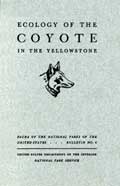.gif)
MENU
![]() Small Mammals
Small Mammals
|
Fauna of the National Parks — No. 4
Ecology of the Coyote in the Yellowstone |

|
CHAPTER X:
SMALL MAMMALS IN RELATION TO COYOTES
POCKET GOPHER
Pocket gophers (Thomomys fuscus fuscus) made up 1,939 or 21.6 percent of the food items. Remains were found in 1,407 droppings. These rodents are active in winter under the snow and are occasionally taken at this time. Predators know the habits of the pocket gopher and have learned to wait for them to reappear above the ground when they are active at the open holes. Once a great grey owl at Yellowstone Lake was observed watching a spot for several minutes and then pouncing on a gopher when it appeared. In summer the coyotes readily capture them by waiting at the tunnel entrances where they are digging or coming out into the open to forage. From the results of the droppings analyses it appears that Thomomys are about as readily captured as field mice.
The coyote is probably one of the chief checks, due to predation, on the pocket gopher population. It is difficult to say how effective this control may be, or how beneficial in a wild region. In a mountain area, any harmful effects of moderately numerous pocket gophers may possibly be balanced by beneficial effects. Importance of the pocket gopher as a factor in erosion is not known. From general observations their activities in this respect seem to be beneficial as well as rather harmful. In some areas where sagebrush is an important deer and antelope winter food, and at the same time in a precarious condition from overbrowsing, coyote predation on pocket gophers may be highly valuable, for these rodents were found to cause considerable local though probably temporary damage to sagebrush during the winter months in places by cutting off branches and twigs. Some bushes were pruned down to within a few inches of the ground. Over most of the park, however, pruning of sagebrush by pocket gophers is probably not very harmful, and the animals are now absent or scarce over the heart of the critical antelope and deer winter ranges in the Gardiner region. Whether coyotes have had much to do with this local scarcity of gophers is not known but possibly the pocket gopher does not care especially for this Upper Sonoran habitat, particularly in its present overbrowsed condition.

Figure 49— Sagebrush trimmed by pocket
gophers in winter. Mice and pocket gophers
are the leading items in
the coyote diet for a large part of the year.
Blacktail Deer
Creek, May 15, 1938.
In the coyote-pocket gopher relationship we find an apparent blending of harmful, beneficial, and neutral influences not readily segregated or measured. The rodent consumes a certain amount of forage, but also does service in soil building, furnishes an important food supply for raptores and carnivores, and acts as a buffer species. On the other hand, the coyote makes inroads on this natural food supply but does not exhaust it, and among birds and mammals certainly is the greatest single factor in keeping the pocket gopher population within safe bounds.
The relative frequency with which pocket gopher and field mouse occurs in the droppings depends upon the locality and possibly on the time of year. In localities where pocket gopher habitat is scarce the percentage of gopher remains is low, but where pocket gopher and field mouse habitats are both present the pocket gopher may occur as frequently or more frequently in the droppings than the field mouse. In droppings gathered at Swan Lake where mice are specially plentiful in the marsh and heavy sedge around the lake and pocket gophers occur on the surrounding slopes, remains of 122 pocket gophers and 256 field mice were identified.
Between Swan Lake Flats and Norris near the road where there is but little pocket gopher habitat, the coyotes hunt mainly in the marsh along the creeks. Droppings gathered here contained remains of 82 pocket gophers and 352 field mice. Where good field mouse habitat predominates and pocket gophers are relatively scarce, gopher-mouse occurrence in the droppings is as follows: Gibbon Meadows and Elk Park, 39—362; Madison Junction, 3—53; Old Faithful, 17—222.
In other localities where pocket gopher habitat occurs extensively along with field mouse habitat, occurrence of the two animals in the droppings does not vary widely. Data from such localities follows:
| Locality | Pocket gophter |
Field mouse |
| Pelican Meadows Hayden Valley Buffalo Ranch Antelope Creek |
622 435 222 121 |
780 436 251 41 |
During July, August, September, and October the relative proportion of pocket gophers to field mice in the droppings is higher than earlier or later in the season. This high pocket gopher incidence probably coincides with a period of greater surface activity. The occurrence of gophers and field mice in the droppings from April to November is as follows:
| Month | Pocket gophter | Field mouse |
Month | Pocket gopher |
Field mouse | |
| April May June July |
17 166 280 122 |
237 513 474 90 |
August September October November |
296 813 86 146 |
172 893 67 567 |
As mentioned before, only the majority, of the droppings gathered in a month were actually deposited that month, but the dates as a whole are probably accurate enough to show the general trend. Availability of the prey species largely determines the extent to which it is eaten.
Continued >>>
 Top
Top
Last Modified: Thurs, Dec 20 2001 10:00:00 pm PDT
http://www.cr.nps.gov/history/online_books/fauna4/fauna10a.htm
![]()
